Abstract
We have used in situ hybridization (ISH) and immunohistochemistry (IHC) to investigate the kinetics of the expression for Fc epsilon RI mRNA (alpha-, beta- and gamma-chains), the alpha-chain protein product, as well as the phenotype of the mRNA- or protein-positive cells in allergen-induced late-phase skin reactions in atopic subjects. Compared with diluent controls, there were significant increases in the total number of mRNA+ cells for the alpha-, beta- and gamma-chains for Fc epsilon RI at all time-points (6, 24 and 48 hr) after allergen challenge (P < 0.01). By double IHC/ISH significant increases in alpha-, beta- and gamma-chain mRNA+ macrophages, eosinophils, mast cells and CD1a+ cells were also observed after allergen challenge (P < 0.05). The distribution of Fc epsilon RI subunit (alpha-, beta-, or gamma-chain) mRNA+ co-localization was CD68+ macrophages (42-47%), EG2+ eosinophils (33-39%), tryptase+ mast cells (5-11%) and CD1a+ Langerhans' cells (2-4%). Using single IHC, significant increases in the total number of Fc epsilon RI protein+ cells (P < 0.01) were observed 24 and 48 hr after allergen challenge. Double IHC showed that the distribution of Fc epsilon RI+ cells was tryptase+ mast cells (33%), CD68+ macrophages (36%), EG2+ eosinophils (20%), CD1a+ Langerhans' cells (4%) and unidentified cells (7%), at the 24-hr allergen-challenged sites. These observations suggest that the cutaneous late-phase reaction in man is associated with up-regulation of Fc epsilon RI on eosinophils, macrophages, mast cells and Langerhans' cells.
Full text
PDF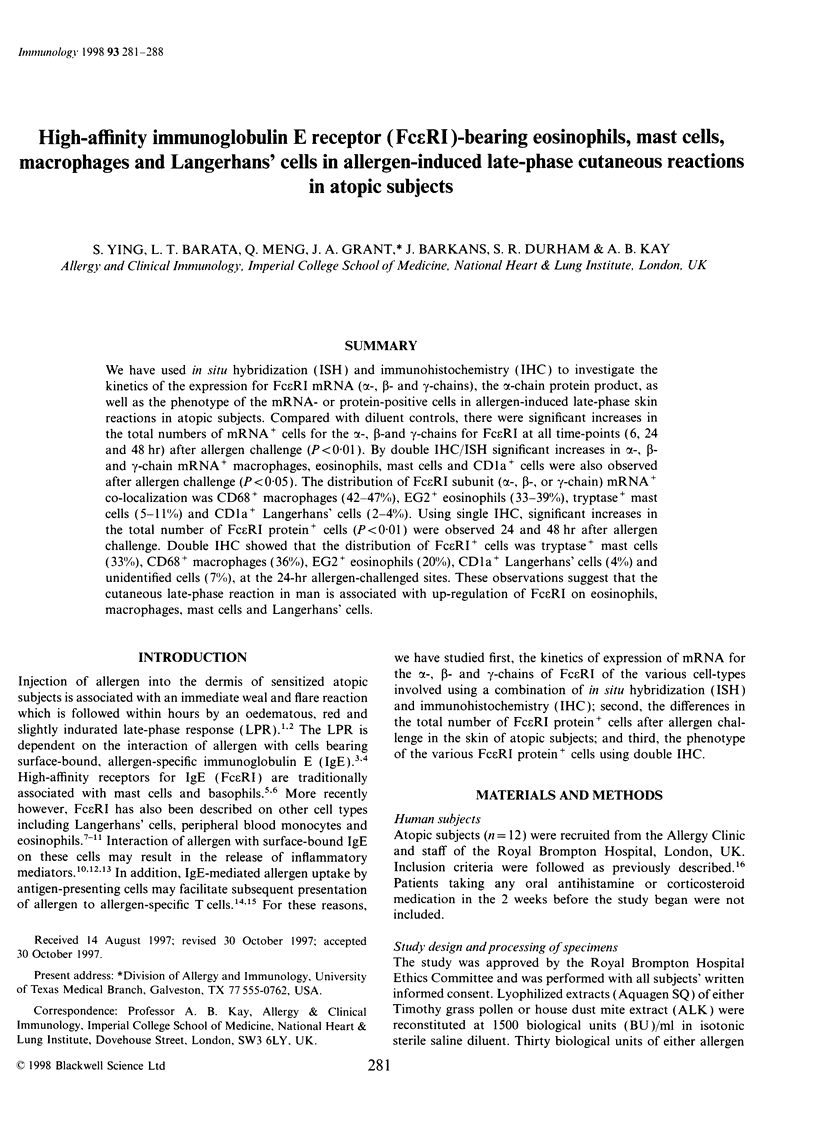
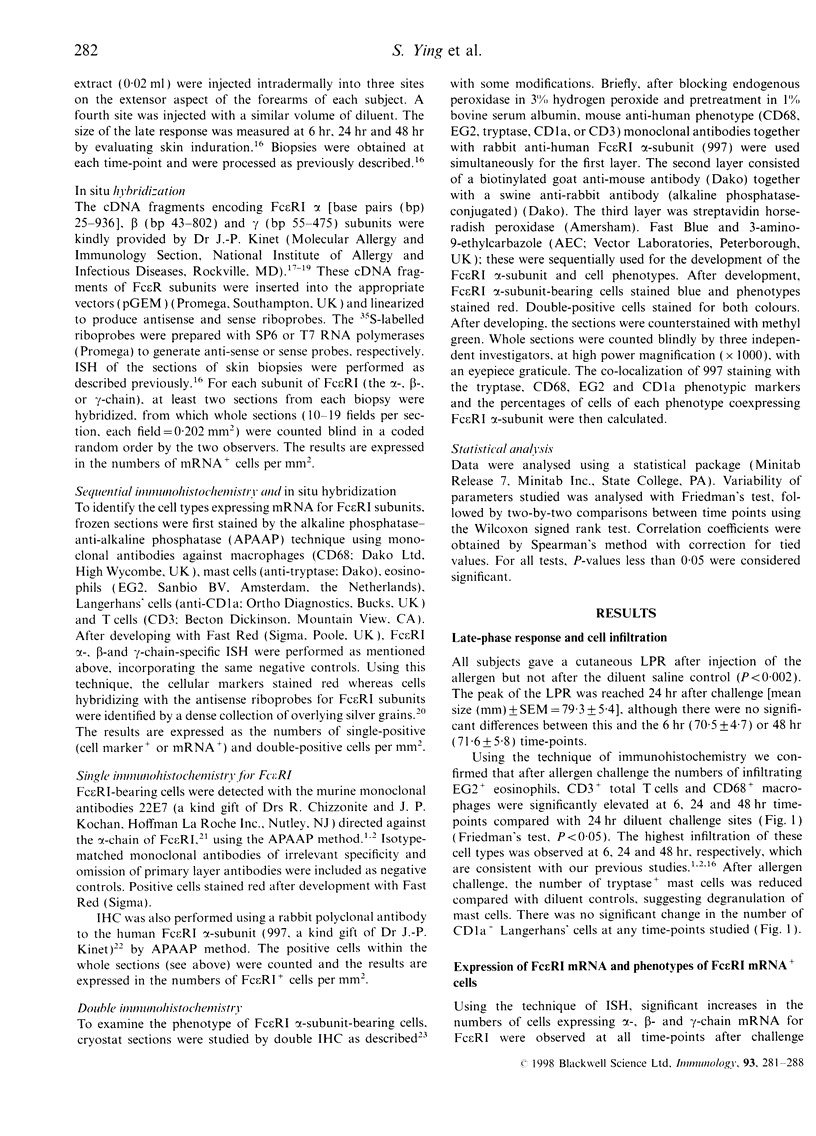
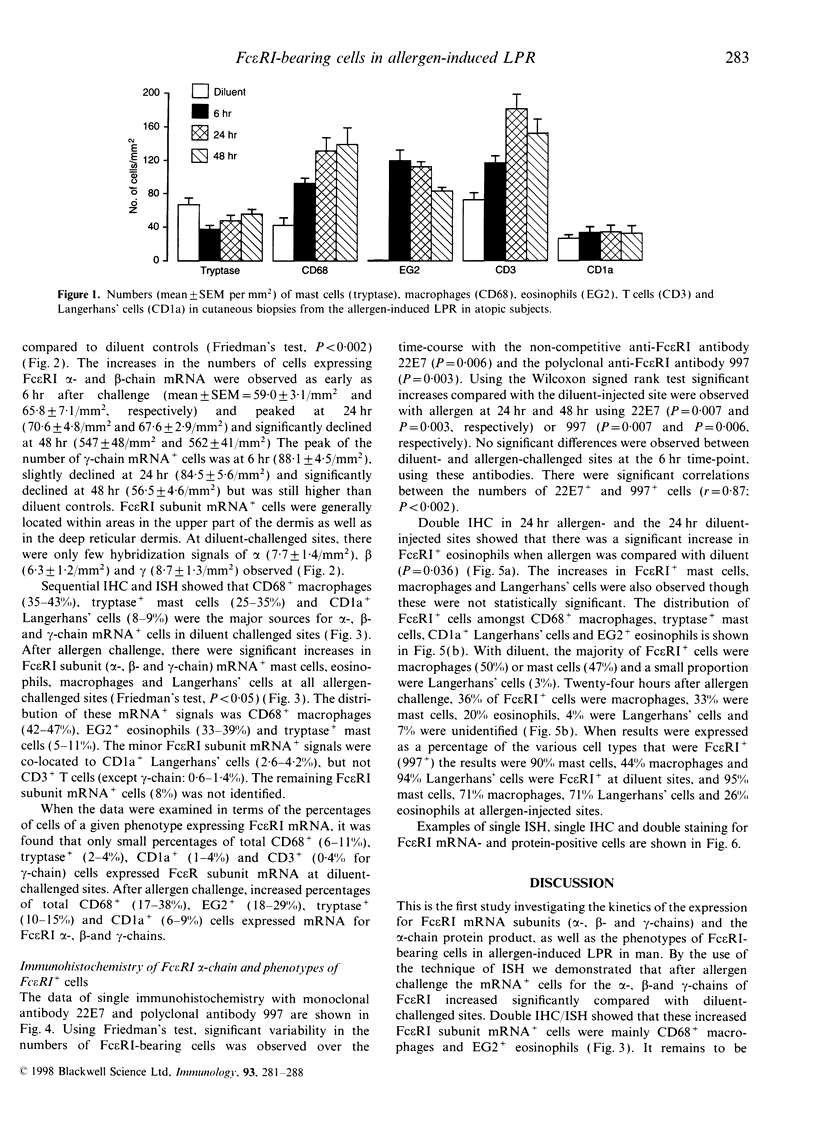
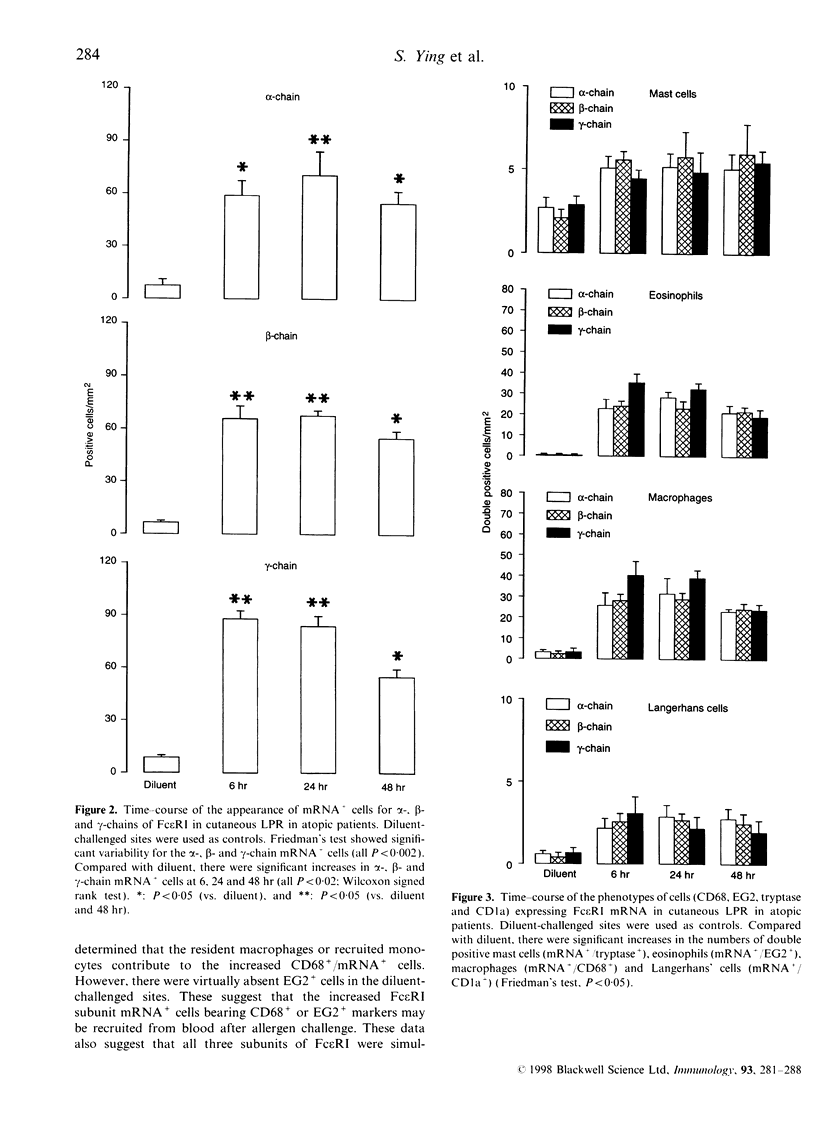
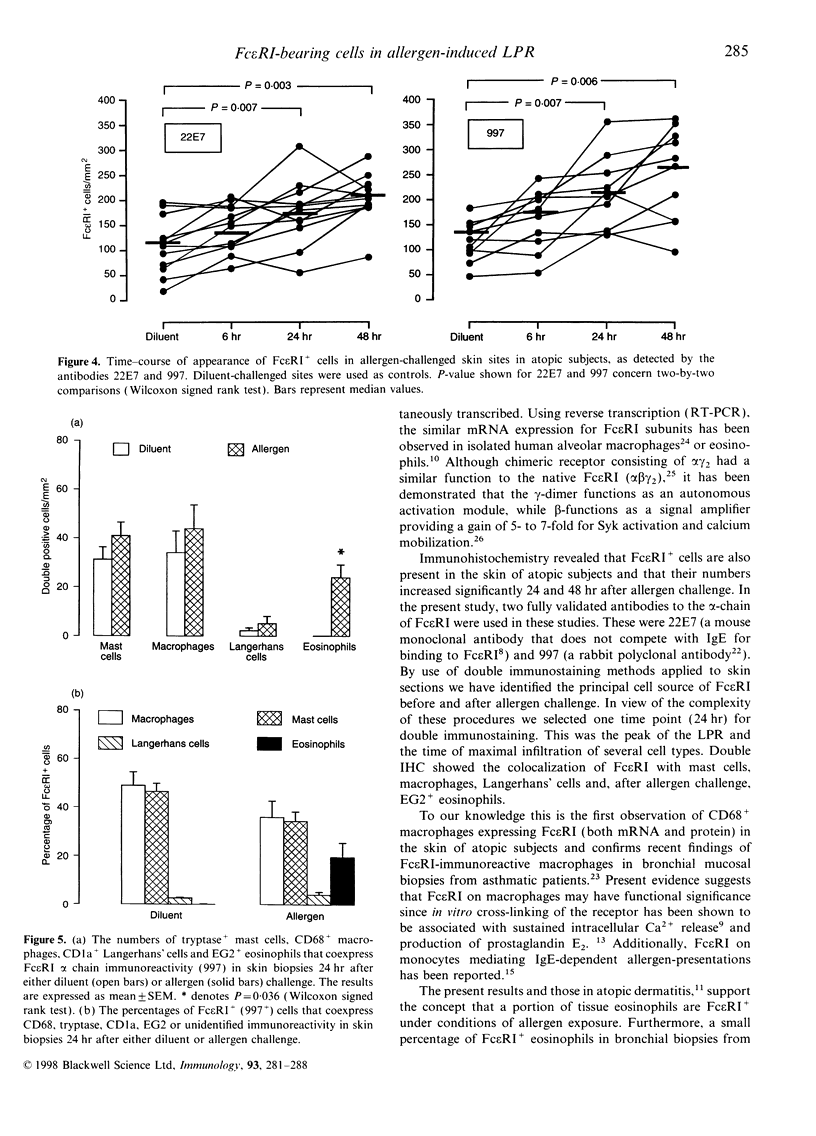
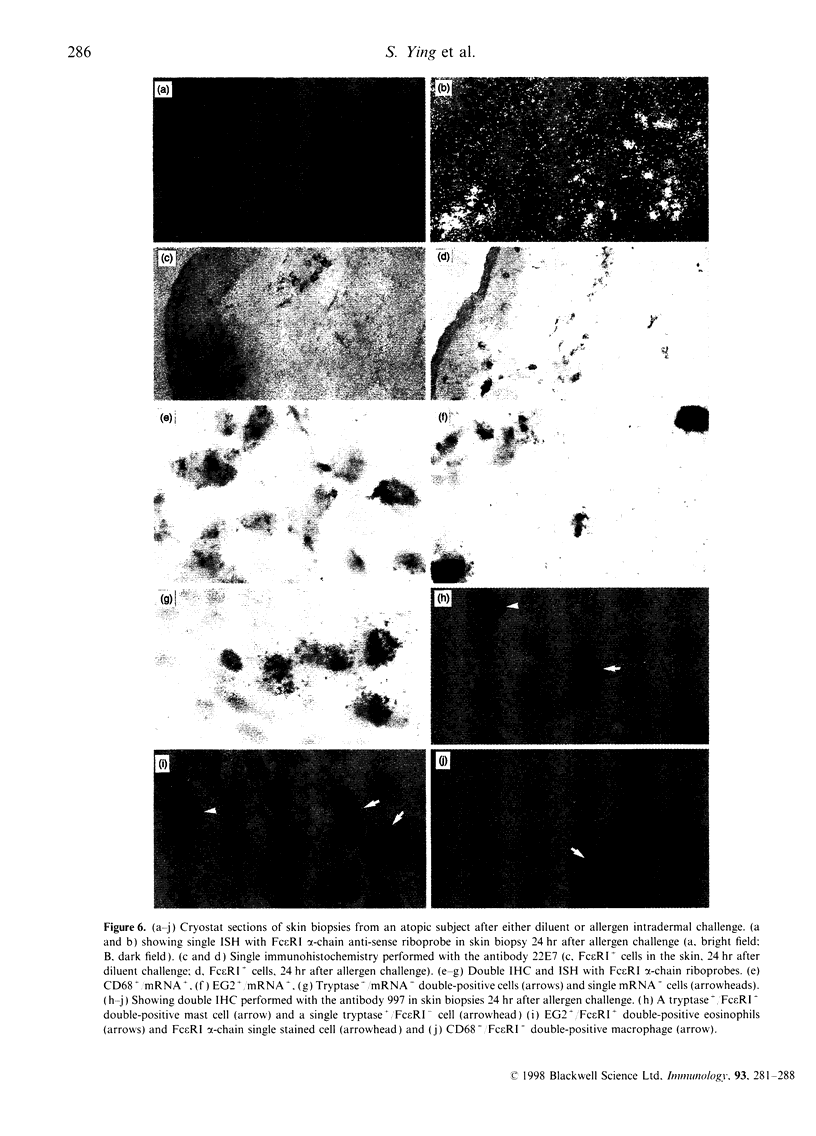
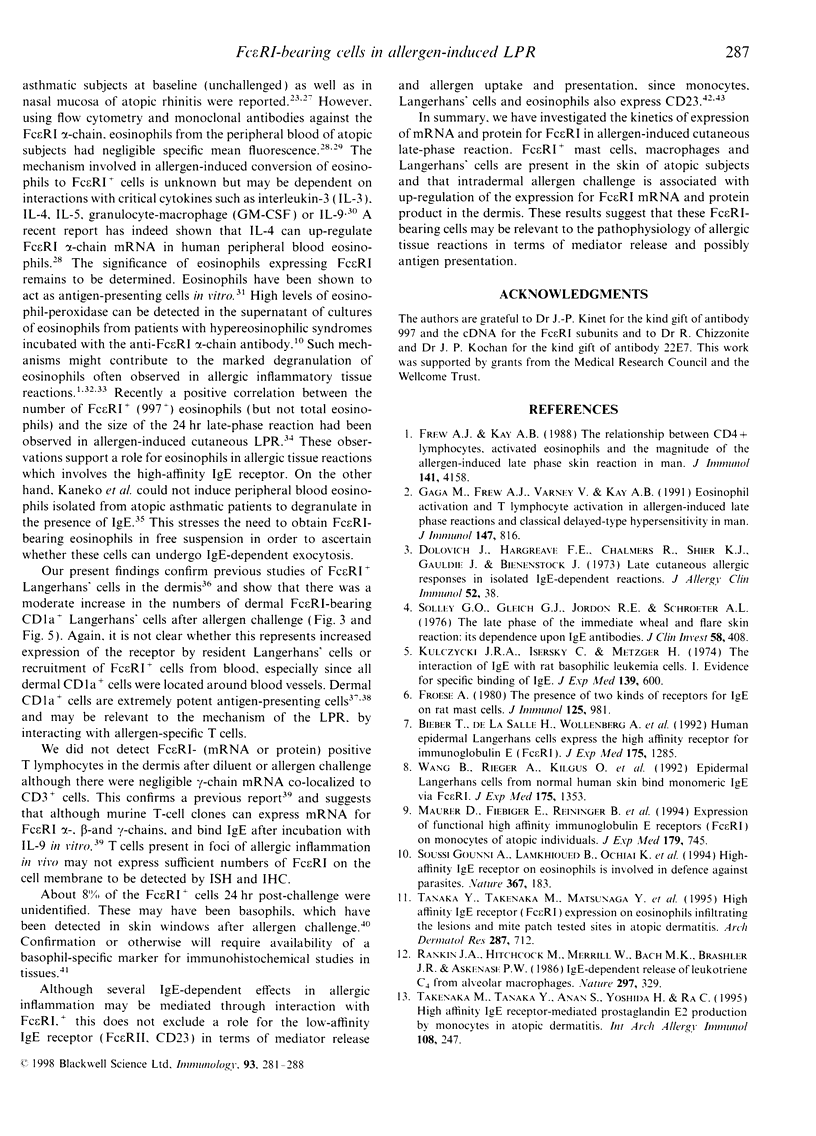
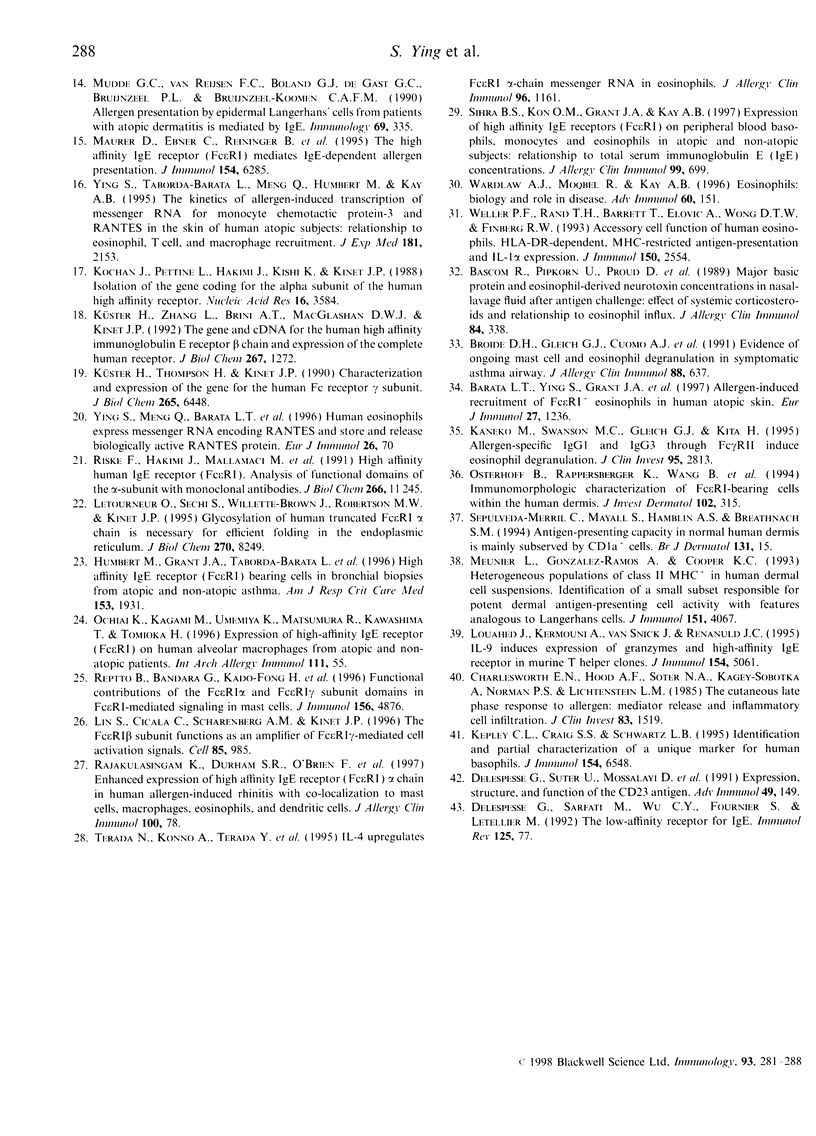
Images in this article
Selected References
These references are in PubMed. This may not be the complete list of references from this article.
- Barata L. T., Ying S., Grant J. A., Humbert M., Barkans J., Meng Q., Durham S. R., Kay A. B. Allergen-induced recruitment of Fc epsilon RI+ eosinophils in human atopic skin. Eur J Immunol. 1997 May;27(5):1236–1241. doi: 10.1002/eji.1830270527. [DOI] [PubMed] [Google Scholar]
- Bascom R., Pipkorn U., Proud D., Dunnette S., Gleich G. J., Lichtenstein L. M., Naclerio R. M. Major basic protein and eosinophil-derived neurotoxin concentrations in nasal-lavage fluid after antigen challenge: effect of systemic corticosteroids and relationship to eosinophil influx. J Allergy Clin Immunol. 1989 Sep;84(3):338–346. doi: 10.1016/0091-6749(89)90418-1. [DOI] [PubMed] [Google Scholar]
- Bieber T., de la Salle H., Wollenberg A., Hakimi J., Chizzonite R., Ring J., Hanau D., de la Salle C. Human epidermal Langerhans cells express the high affinity receptor for immunoglobulin E (Fc epsilon RI). J Exp Med. 1992 May 1;175(5):1285–1290. doi: 10.1084/jem.175.5.1285. [DOI] [PMC free article] [PubMed] [Google Scholar]
- Broide D. H., Gleich G. J., Cuomo A. J., Coburn D. A., Federman E. C., Schwartz L. B., Wasserman S. I. Evidence of ongoing mast cell and eosinophil degranulation in symptomatic asthma airway. J Allergy Clin Immunol. 1991 Oct;88(4):637–648. doi: 10.1016/0091-6749(91)90158-k. [DOI] [PubMed] [Google Scholar]
- Charlesworth E. N., Hood A. F., Soter N. A., Kagey-Sobotka A., Norman P. S., Lichtenstein L. M. Cutaneous late-phase response to allergen. Mediator release and inflammatory cell infiltration. J Clin Invest. 1989 May;83(5):1519–1526. doi: 10.1172/JCI114047. [DOI] [PMC free article] [PubMed] [Google Scholar]
- Delespesse G., Suter U., Mossalayi D., Bettler B., Sarfati M., Hofstetter H., Kilcherr E., Debre P., Dalloul A. Expression, structure, and function of the CD23 antigen. Adv Immunol. 1991;49:149–191. doi: 10.1016/s0065-2776(08)60776-2. [DOI] [PubMed] [Google Scholar]
- Frew A. J., Kay A. B. The relationship between infiltrating CD4+ lymphocytes, activated eosinophils, and the magnitude of the allergen-induced late phase cutaneous reaction in man. J Immunol. 1988 Dec 15;141(12):4158–4164. [PubMed] [Google Scholar]
- Gaga M., Frew A. J., Varney V. A., Kay A. B. Eosinophil activation and T lymphocyte infiltration in allergen-induced late phase skin reactions and classical delayed-type hypersensitivity. J Immunol. 1991 Aug 1;147(3):816–822. [PubMed] [Google Scholar]
- Gounni A. S., Lamkhioued B., Ochiai K., Tanaka Y., Delaporte E., Capron A., Kinet J. P., Capron M. High-affinity IgE receptor on eosinophils is involved in defence against parasites. Nature. 1994 Jan 13;367(6459):183–186. doi: 10.1038/367183a0. [DOI] [PubMed] [Google Scholar]
- Humbert M., Grant J. A., Taborda-Barata L., Durham S. R., Pfister R., Menz G., Barkans J., Ying S., Kay A. B. High-affinity IgE receptor (FcepsilonRI)-bearing cells in bronchial biopsies from atopic and nonatopic asthma. Am J Respir Crit Care Med. 1996 Jun;153(6 Pt 1):1931–1937. doi: 10.1164/ajrccm.153.6.8665058. [DOI] [PubMed] [Google Scholar]
- Kaneko M., Swanson M. C., Gleich G. J., Kita H. Allergen-specific IgG1 and IgG3 through Fc gamma RII induce eosinophil degranulation. J Clin Invest. 1995 Jun;95(6):2813–2821. doi: 10.1172/JCI117986. [DOI] [PMC free article] [PubMed] [Google Scholar]
- Kepley C. L., Craig S. S., Schwartz L. B. Identification and partial characterization of a unique marker for human basophils. J Immunol. 1995 Jun 15;154(12):6548–6555. [PubMed] [Google Scholar]
- Kochan J., Pettine L. F., Hakimi J., Kishi K., Kinet J. P. Isolation of the gene coding for the alpha subunit of the human high affinity IgE receptor. Nucleic Acids Res. 1988 Apr 25;16(8):3584–3584. doi: 10.1093/nar/16.8.3584. [DOI] [PMC free article] [PubMed] [Google Scholar]
- Kulczycki A., Jr, Isersky C., Metzger H. The interaction of IgE with rat basophilic leukemia cells. I. Evidence for specific binding of IgE. J Exp Med. 1974 Mar 1;139(3):600–616. doi: 10.1084/jem.139.3.600. [DOI] [PMC free article] [PubMed] [Google Scholar]
- Küster H., Thompson H., Kinet J. P. Characterization and expression of the gene for the human Fc receptor gamma subunit. Definition of a new gene family. J Biol Chem. 1990 Apr 15;265(11):6448–6452. [PubMed] [Google Scholar]
- Letourneur O., Sechi S., Willette-Brown J., Robertson M. W., Kinet J. P. Glycosylation of human truncated Fc epsilon RI alpha chain is necessary for efficient folding in the endoplasmic reticulum. J Biol Chem. 1995 Apr 7;270(14):8249–8256. doi: 10.1074/jbc.270.14.8249. [DOI] [PubMed] [Google Scholar]
- Lin S., Cicala C., Scharenberg A. M., Kinet J. P. The Fc(epsilon)RIbeta subunit functions as an amplifier of Fc(epsilon)RIgamma-mediated cell activation signals. Cell. 1996 Jun 28;85(7):985–995. doi: 10.1016/s0092-8674(00)81300-8. [DOI] [PubMed] [Google Scholar]
- Maurer D., Ebner C., Reininger B., Fiebiger E., Kraft D., Kinet J. P., Stingl G. The high affinity IgE receptor (Fc epsilon RI) mediates IgE-dependent allergen presentation. J Immunol. 1995 Jun 15;154(12):6285–6290. [PubMed] [Google Scholar]
- Maurer D., Fiebiger E., Reininger B., Wolff-Winiski B., Jouvin M. H., Kilgus O., Kinet J. P., Stingl G. Expression of functional high affinity immunoglobulin E receptors (Fc epsilon RI) on monocytes of atopic individuals. J Exp Med. 1994 Feb 1;179(2):745–750. doi: 10.1084/jem.179.2.745. [DOI] [PMC free article] [PubMed] [Google Scholar]
- Meunier L., Gonzalez-Ramos A., Cooper K. D. Heterogeneous populations of class II MHC+ cells in human dermal cell suspensions. Identification of a small subset responsible for potent dermal antigen-presenting cell activity with features analogous to Langerhans cells. J Immunol. 1993 Oct 15;151(8):4067–4080. [PubMed] [Google Scholar]
- Mudde G. C., Van Reijsen F. C., Boland G. J., de Gast G. C., Bruijnzeel P. L., Bruijnzeel-Koomen C. A. Allergen presentation by epidermal Langerhans' cells from patients with atopic dermatitis is mediated by IgE. Immunology. 1990 Mar;69(3):335–341. [PMC free article] [PubMed] [Google Scholar]
- Rankin J. A., Hitchcock M., Merrill W., Bach M. K., Brashler J. R., Askenase P. W. IgE-dependent release of leukotriene C4 from alveolar macrophages. Nature. 1982 May 27;297(5864):329–331. doi: 10.1038/297329a0. [DOI] [PubMed] [Google Scholar]
- Repetto B., Bandara G., Kado-Fong H., Larigan J. D., Wiggan G. A., Pocius D., Basu M., Gilfillan A. M., Kochan J. P. Functional contributions of the FcepsilonRIalpha and FepsilonRIgamma subunit domains in FcepsilonRI-mediated signaling in mast cells. J Immunol. 1996 Jun 15;156(12):4876–4883. [PubMed] [Google Scholar]
- Sepulveda-Merrill C., Mayall S., Hamblin A. S., Breathnach S. M. Antigen-presenting capacity in normal human dermis is mainly subserved by CD1a+ cells. Br J Dermatol. 1994 Jul;131(1):15–22. doi: 10.1111/j.1365-2133.1994.tb08451.x. [DOI] [PubMed] [Google Scholar]
- Sihra B. S., Kon O. M., Grant J. A., Kay A. B. Expression of high-affinity IgE receptors (Fc epsilon RI) on peripheral blood basophils, monocytes, and eosinophils in atopic and nonatopic subjects: relationship to total serum IgE concentrations. J Allergy Clin Immunol. 1997 May;99(5):699–706. doi: 10.1016/s0091-6749(97)70033-2. [DOI] [PubMed] [Google Scholar]
- Solley G. O., Gleich G. J., Jordon R. E., Schroeter A. L. The late phase of the immediate wheal and flare skin reaction. Its dependence upon IgE antibodies. J Clin Invest. 1976 Aug;58(2):408–420. doi: 10.1172/JCI108485. [DOI] [PMC free article] [PubMed] [Google Scholar]
- Takenaka M., Tanaka Y., Anan S., Yoshida H., Ra C. High affinity IgE receptor-mediated prostaglandin E2 production by monocytes in atopic dermatitis. Int Arch Allergy Immunol. 1995 Nov;108(3):247–253. doi: 10.1159/000237160. [DOI] [PubMed] [Google Scholar]
- Tanaka Y., Takenaka M., Matsunaga Y., Okada S., Anan S., Yoshida H., Ra C. High affinity IgE receptor (Fc epsilon RI) expression on eosinophils infiltrating the lesions and mite patch tested sites in atopic dermatitis. Arch Dermatol Res. 1995;287(8):712–717. doi: 10.1007/BF01105794. [DOI] [PubMed] [Google Scholar]
- Terada N., Konno A., Terada Y., Fukuda S., Yamashita T., Abe T., Shimada H., Ishida K., Yoshimura K., Tanaka Y. IL-4 upregulates Fc epsilon RI alpha-chain messenger RNA in eosinophils. J Allergy Clin Immunol. 1995 Dec;96(6 Pt 2):1161–1169. doi: 10.1016/s0091-6749(95)70201-6. [DOI] [PubMed] [Google Scholar]
- Wang B., Rieger A., Kilgus O., Ochiai K., Maurer D., Födinger D., Kinet J. P., Stingl G. Epidermal Langerhans cells from normal human skin bind monomeric IgE via Fc epsilon RI. J Exp Med. 1992 May 1;175(5):1353–1365. doi: 10.1084/jem.175.5.1353. [DOI] [PMC free article] [PubMed] [Google Scholar]
- Weller P. F., Rand T. H., Barrett T., Elovic A., Wong D. T., Finberg R. W. Accessory cell function of human eosinophils. HLA-DR-dependent, MHC-restricted antigen-presentation and IL-1 alpha expression. J Immunol. 1993 Mar 15;150(6):2554–2562. [PubMed] [Google Scholar]
- Ying S., Taborda-Barata L., Meng Q., Humbert M., Kay A. B. The kinetics of allergen-induced transcription of messenger RNA for monocyte chemotactic protein-3 and RANTES in the skin of human atopic subjects: relationship to eosinophil, T cell, and macrophage recruitment. J Exp Med. 1995 Jun 1;181(6):2153–2159. doi: 10.1084/jem.181.6.2153. [DOI] [PMC free article] [PubMed] [Google Scholar]



